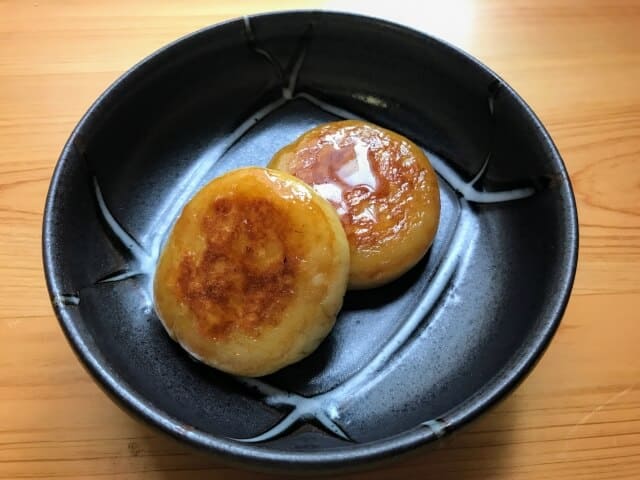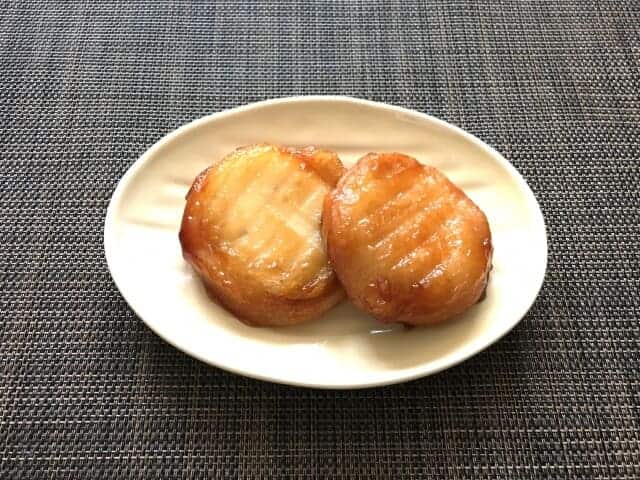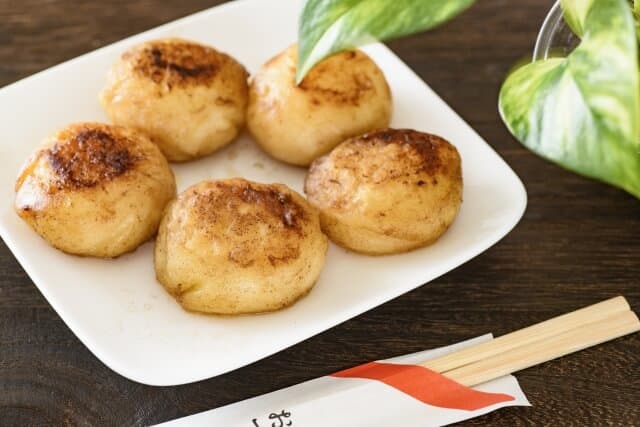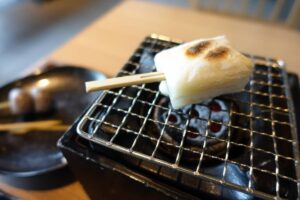Imo Mochi is a delightful Japanese treat made from glutinous rice and sweet potatoes, resulting in a chewy and flavorful snack that captures the essence of autumn. With its soft texture and naturally sweet taste, this popular delicacy is often enjoyed during festivals and family gatherings. If you’re curious about how Imo Mochi is made, its cultural significance, and the best places to try it, keep reading to explore the delicious world of this beloved Japanese confection!
What is Imo mochi?

Imo mochi (いももち) is a Japanese snack made from a combination of sweet potatoes and glutinous rice flour. The sweet potatoes are typically steamed or boiled, mashed, and then mixed with the rice flour to form a dough. This mixture is shaped into small balls or cakes and can be either steamed or pan-fried. Imo mochi is often enjoyed as a sweet treat, sometimes coated in a layer of soy sauce or served with a sprinkling of kinako (roasted soybean flour) or sugar. It has a chewy texture and a slightly sweet, earthy flavor, making it a popular snack, especially in colder months or as part of seasonal festivals.
There are dishes called imomochi all over the country, but the type of potato used and cooking method differ from region to region. Potatoes are available all year round, so they are eaten all year round, and are characterized by a chewy texture similar to mochi. The potato varieties that are most suitable for use are Danshaku Imo and Kitaakari, which are sweet and sticky.
Imo Mochi history

Hokkaido’s imomochi is said to be linked to the history of development. When Hokkaido’s development began after the Meiji Restoration, there was initially a serious problem of food shortages, as rice cultivation techniques suited to the cold climate had not been established. As a result, potatoes, which are easy to grow, began to be cultivated as a substitute for rice. Imomochi originated from mochi, which was made using potatoes as a substitute for rice. After that, imomochi, which is high in calories, became a valuable source of energy for pioneers, and because it is easy to prepare and delicious, it spread to the general public as well. It was also treasured during and after the war, when there was a food shortage, and is now a staple snack loved by a wide range of generations.
Main way to eat

The most common version is a sweet and spicy sauce made from sugar and soy sauce, similar to mitarashi, but depending on the region and household, it can be seasoned with a variety of seasonings, such as salt or sesame sauce. You can also prepare this in a variety of ways, such as with cheese or cod roe inside and baked or fried. A dish with potato mochi in soup is called “dango soup” and is a standard dish in school lunches in Hokkaido.
Imo Mochi Recipe
Ingredients of Imo Mochi Miso Soup
| Potato mochi | 240g |
| Dashi soup | 400g |
| Miso | 30g |
| Green onion | 20-30g |
How to make Imo Mochi Miso Soup?
STEP
Cook the Mochi in Broth
Bring water and Japanese-style stock to a boil in a pot. Add the potato mochi and cook over low heat until soft. Turn off the heat, add the miso, and dissolve it well. Return the pot to the heat and warm it over medium heat.
STEP
Serve and Garnish
Pour the mixture into a bowl. Garnish with finely chopped green onions.
For reference of the recipe, you can find it here:
https://traditional-foods.maff.go.jp/menu/imomochi/
FAQ
Imomomo in Hokkaido is especially recommended to be eaten in winter. During this time of year, imomomo has a warm and wholesome flavor, making it a perfect dish for the cold season.
The most common and standard seasoning is sweet and spicy soy sauce and sugar. The flavor of freshly baked imo-mo (sweet potato cake) is enhanced by dipping it in the sweet and spicy sauce made from soy sauce and sugar. The simple but delicious salt flavor is also popular!
Recommended Restaurants for Imo Mochi
Imochiya (いももちや)

Nanae Town is an agricultural community known for being the birthplace of Danshaku potatoes. One of the local specialties is “imo-mochi,” a delicious dish made from these potatoes. This recipe comes from Grandma Kimiko, an 86-year-old expert in making potato mochi. The dish features a flavorful broth made from local ingredients, including Hakodate kelp, mackerel flakes, bonito flakes, and dried sardines. The stock is carefully prepared to enhance the dish’s taste. This restaurant proudly uses fresh, local ingredients to create its meals.
Address: 380-2 Togeshita, Nanae, Kameda District, Hokkaido 041-1102, Japan
Hours open: 10:00- 16:00 Closed on Tuesdays and Wednesdays
Website: https://imomochiya4.webnode.jp/
Summary

In conclusion, Imo Mochi is more than just a tasty treat; it’s a delightful representation of Japanese culinary tradition, especially during the autumn season. We hope this article has given you a better understanding of its unique flavors and cultural significance. Whether you’re planning a visit to Japan or looking to try your hand at making it yourself, we encourage you to experience Imo Mochi firsthand. We’re confident you’ll enjoy this chewy, sweet delicacy as much as many others do!
There are other more varieties of mochi you can try out when you go visit Japan. Some of these mochi are we can recommend and guaranteed you will like it!
mochi rice cake

Mochi (餅) Introduction to Mochi When it comes to traditional Japanese desserts, Mochi is always the answer. This traditional dessert is famous for “rice cake,” enjoy b…
mochi with anko red beans

Anko Mochi (あんこ餅) Among Japanese sweets, mochi is a very popular one not only in Japan but also all around the world. However, do you know that there is not only one type of m…
botamochi

Botamochi (牡丹餅) Botamochi is a popular snack and dessert in Japan and locals often served them at tea ceremonies and other special occasions. You can also find them in many …

 1 month ago
18
1 month ago
18










 English (US) ·
English (US) ·